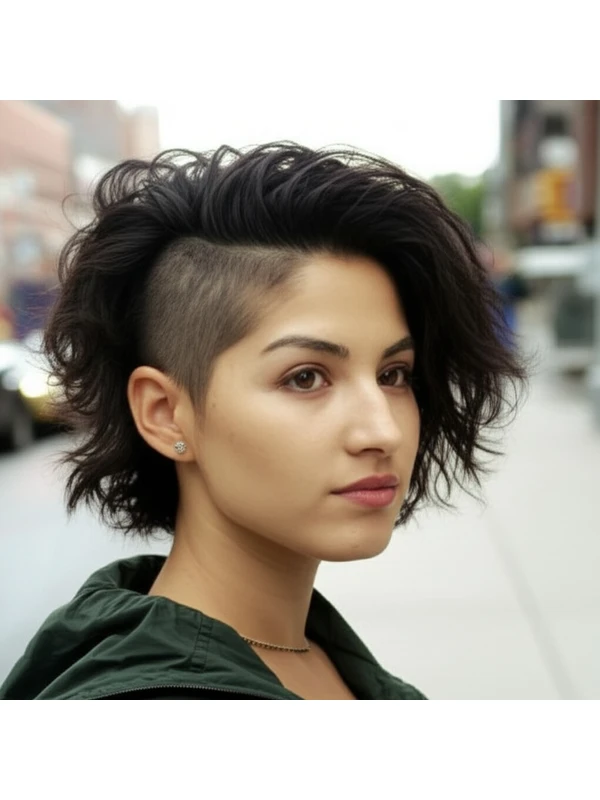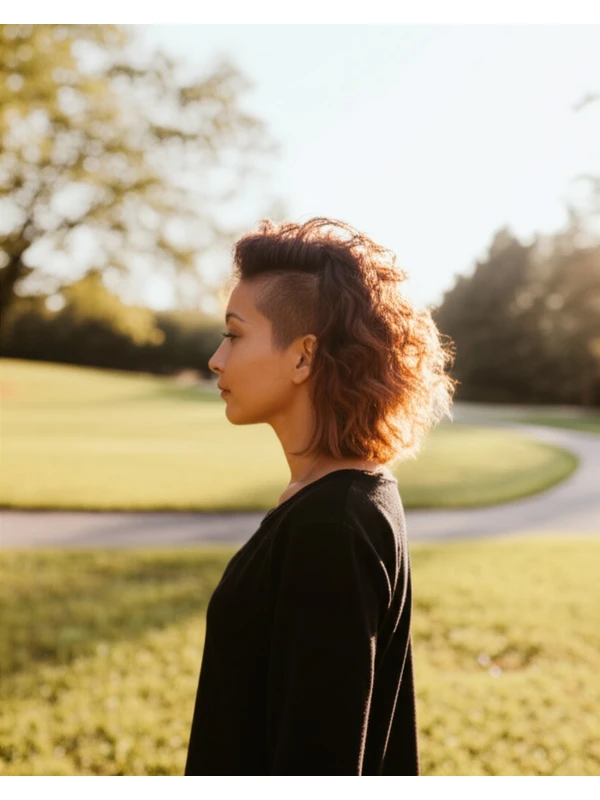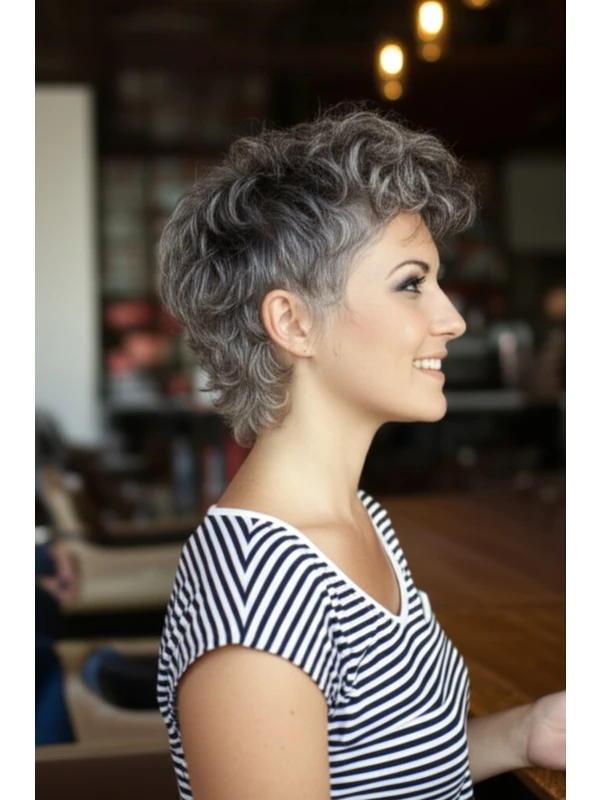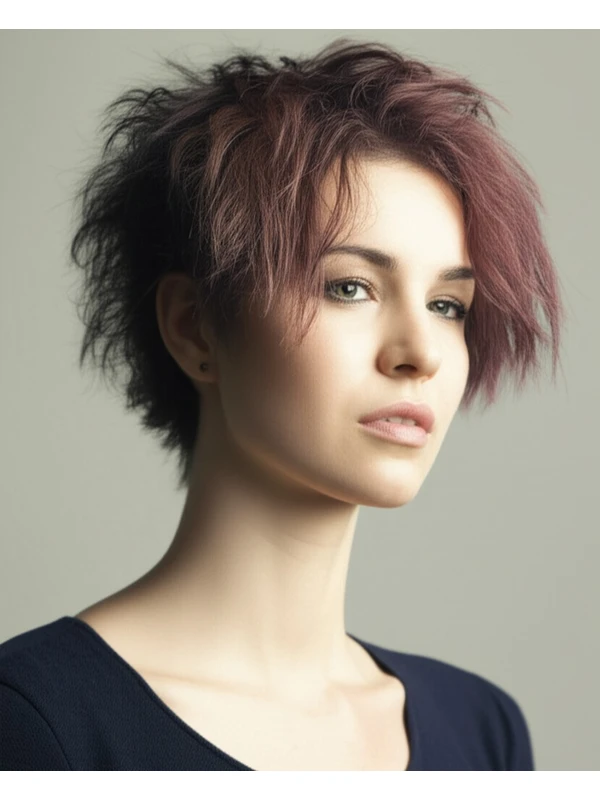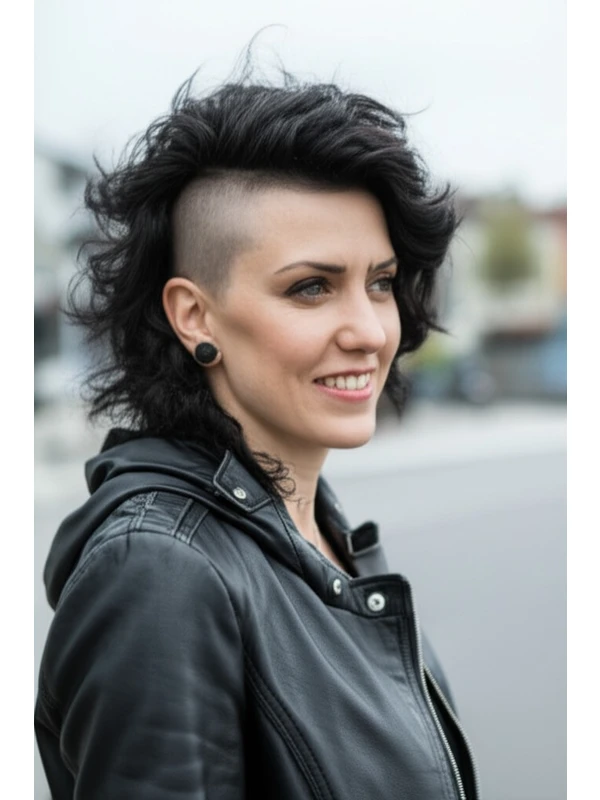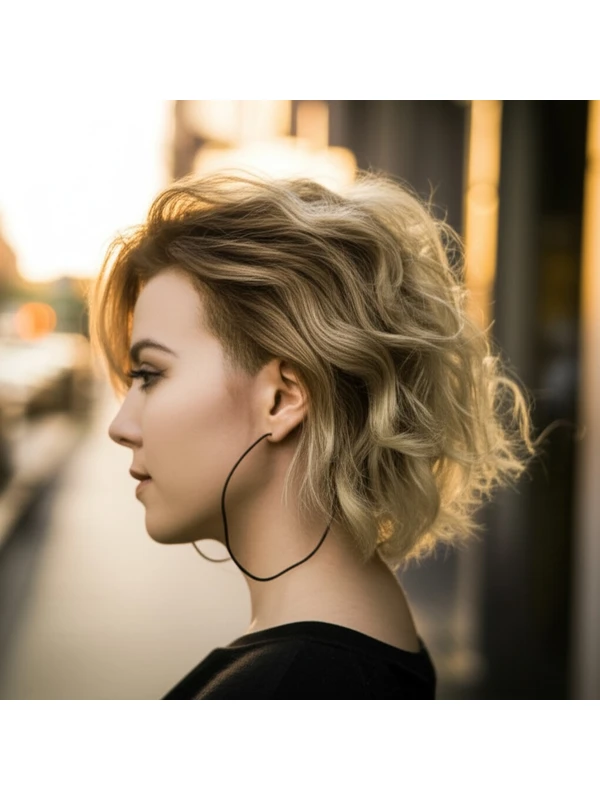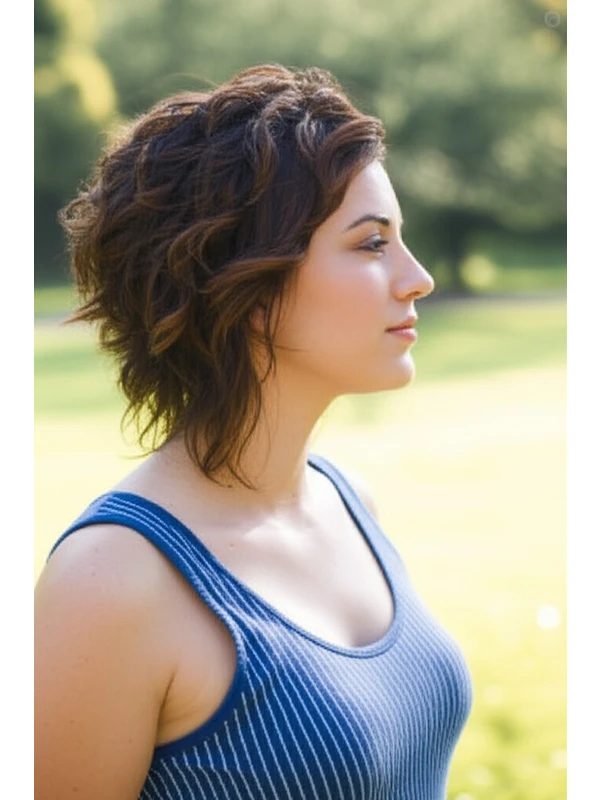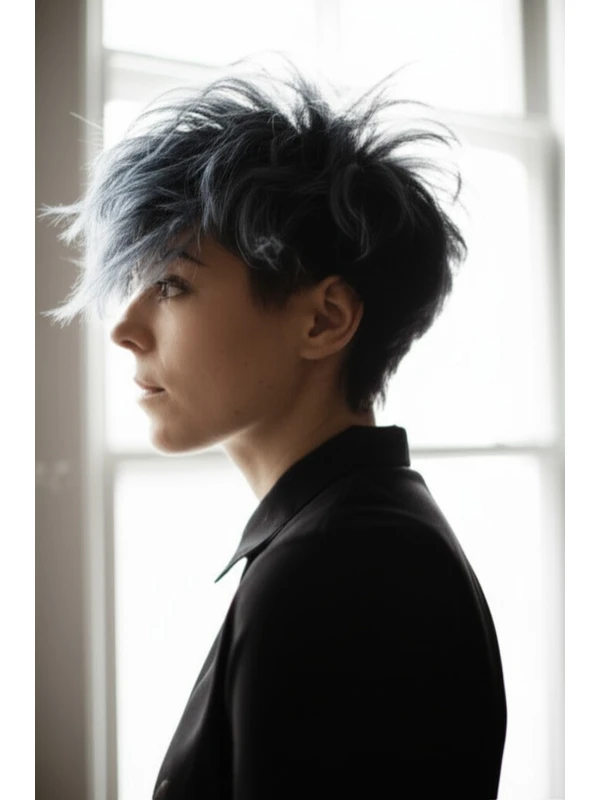#The Faux Hawk: A Bold & Versatile Style Guide
The faux hawk – it's edgy, modern, and surprisingly adaptable! This guide breaks down everything you need to know about this statement hairstyle, from finding the perfect fit for your face shape to mastering daily styling. Let’s dive in!
#1) Background & Definition: What is a Faux Hawk?
The faux hawk (often shortened to "fauxie") isn't actually shaved like a traditional Mohawk. Instead, it mimics the look of one using clever cutting and styling techniques. Think of it as an elevated ponytail with attitude!
- Cut Geometry: The core concept involves creating a raised section of hair down the center of your head, mimicking the ridge of a mohawk. The sides are typically shorter or tapered to emphasize this central peak.
- Key Features: It's all about height, texture (or sleekness!), and contrast between the top/center section and the sides.
- Typical Length Ranges: The center section can range from just a few inches long for a more subtle look to 6+ inches for dramatic volume. Sides are usually much shorter – anywhere from buzzed close to a longer, blended taper.
- Alternative Names: "Faux Hawk," "Mini Mohawk," “Center-Parted Punk,” “Elevated Ponytail.”
#2) Face Shape Fit: Finding Your Angle
The faux hawk can flatter many face shapes with the right adjustments! Here's how it works for different geometries.
- Oval: Lucky you! Oval faces are generally considered the most balanced, so almost any variation of a faux hawk will work well. A slightly off-center part adds asymmetry and interest. Fringe Option: A wispy, textured fringe can soften the look.
- Round: The height of a faux hawk helps elongate a round face. Avoid too much volume at the cheeks – focus on height directly above the forehead. Fringe Option: A side-swept fringe or long, angled bangs help break up the fullness.
- Square: Soften those strong angles! A softer, textured faux hawk with blended sides is ideal. Avoid harsh lines and a very severe center part. Fringe Option: Curtain bangs that frame the face gently are a great choice.
- Heart: The volume of a faux hawk can balance out a wider forehead in heart-shaped faces. Keep the sides relatively short to avoid widening the lower portion of your face. Fringe Option: A soft, piecey fringe or wispy bangs work well without adding too much width.
- Diamond: Similar to heart shapes, diamond faces benefit from volume at the crown. A faux hawk with a slightly angled center part can soften angles and create balance. Fringe Option: Side-swept bangs that blend into the overall style are flattering.
- Oblong (Long): While height is generally good for elongating faces, be careful not to make your face appear even longer! Keep the faux hawk more moderate in height and consider adding width with textured sides or a softer fringe. Fringe Option: A blunt, straight-across fringe can help shorten the appearance of an oblong face.
#3) Body Proportions & Height Guidance
Your body type also influences how a faux hawk will look!
- Petite: Shorter center sections and more subtle height are best to avoid overwhelming your frame.
- Average: You have more flexibility! Experiment with different lengths and volumes.
- Tall: A longer, more dramatic faux hawk can balance your height beautifully.
- Narrow Shoulders: Volume at the crown creates a wider visual silhouette.
- Broad Shoulders: Avoid excessive volume directly above the shoulders to prevent an overly bulky look. Focus on verticality rather than horizontal width.
- Short Neck: Moderate height is key; too much can accentuate a shorter neck.
- Long Neck: You can pull off more dramatic height and length without looking disproportionate.
#4) Works Best With Hair Types & Densities
The faux hawk's versatility shines here! However, some adjustments are needed based on your hair’s natural tendencies.
- Straight Hair: A sleek faux hawk is achievable with the right products (see Section 6). Volume can be created using teasing or strategic blow-drying.
- Wavy Hair: Your natural texture adds instant volume and movement! Embrace it with a more textured, undone style.
- Curly/Coily Hair: The faux hawk looks incredible on curls and coils! Shrinkage is key to consider – what looks like 6 inches in the salon might end up being 4-5 inches after drying. Communicate this shrinkage to your stylist.
- Fine Hair: Focus on creating the illusion of volume with strategic layering and teasing (if desired). Avoid heavy products that can weigh hair down.
- Medium/Thick Hair: You have a lot of options! Experiment with different lengths, volumes, and textures.
- Density Tips: For low-density hair, consider adding layers to create the illusion of more volume. For high-density hair, thinning shears may be used during cutting to reduce bulk.
#5) Styling Variations: From Sleek to Textured
The faux hawk isn't a one-size-fits-all style!
- Sleek vs. Textured: A sleek version uses smoothing serums and flat irons for a polished look. Texturized versions embrace natural waves or curls with texturizing sprays and minimal heat styling.
- Middle vs. Side Part: A center part emphasizes symmetry, while an off-center part adds asymmetry and softness.
- Fringe Variations: Wispy, blunt, side-swept – the possibilities are endless! Consider your face shape (see Section 2).
- Occasion Styling:
- Casual: A messy, textured faux hawk is perfect for everyday wear.
- Office: A sleek and polished version with a subtle center part exudes professionalism.
- Evening: Amp up the drama with height, texture, and statement accessories (like embellished clips or headbands).
#6) Maintenance: Keeping Your Style Sharp
- Trim Cadence: Every 4-8 weeks to maintain shape. Curly/coily hair may require more frequent trims due to shrinkage.
- At-Home Routine: Regular deep conditioning is essential, especially for dry or damaged hair.
- Heat vs. Air Dry: Minimize heat styling whenever possible to protect your hair's health. When using heat, always use a heat protectant!
- Product Checklist:
- Shampoo & Conditioner: Tailored to your hair type.
- Leave-In Conditioner: Provides moisture and detangling benefits.
- Styler (Mousse, Gel, Pomade): For hold and texture/sleekness.
- Finishing Spray: To lock in the style and add shine.
- Estimated Daily Styling Time: 15-45 minutes depending on hair type and desired level of detail.
#7) Grow-Out Roadmap: The Evolution
- Months 1-3: The faux hawk is at its most defined. Regular trims are crucial to maintain the shape.
- Months 3-6: As the center section grows, it may require more styling effort to keep the height and definition. Consider adjusting the cut slightly to accommodate growth. You can start transitioning into a longer layered style if desired.
- Maintaining Shape: Talk to your stylist about techniques for blending out the faux hawk as it grows – subtle layering or face-framing pieces can soften the transition.
#8) Color Pairings: Amplifying the Look
- Cool Undertones (Ash Blondes, Cool Browns): A sleek silver or icy blonde faux hawk creates a modern, edgy vibe.
- Warm Undertones (Golden Blondes, Warm Browns): A rich caramel or copper hue adds warmth and dimension.
- Low-Commitment Options: Balayage or highlights can add subtle pops of color without a full commitment. Consider an ombre effect fading from darker roots to lighter ends in the center section for added visual interest.
#9) Season & Occasion Guide: Adapting Your Style
- Spring/Summer: A more relaxed, textured faux hawk with beachy waves or loose curls is perfect for warmer weather.
- Fall/Winter: A sleeker, more polished version can be paired with cozy sweaters and statement accessories.
- Work: Keep it professional – a sleek style with minimal height.
- Weddings: A romantic, textured faux hawk with delicate braids or embellishments is stunning for formal events.
- Parties: Go bold! Experiment with vibrant colors, dramatic height, and eye-catching accessories.
#10) Cost & Time: Salon Investment
- Salon Time: Typically 60-90 minutes for the initial cut. Styling time can add an extra 30-60 minutes.
- Price Range: Expect to pay a moderate to high price range, depending on your location and stylist's experience.
#11) Pros & Cons: The Trade-offs
Pros: Edgy style, versatile (can be dressed up or down), flattering for many face shapes, creates volume. Cons: Requires regular maintenance trims, can take time to style daily, may not be suitable for very fine hair without careful layering.
#12) Salon Consultation Script: Your Questions
Here are some prompts to guide your conversation with your stylist:
- "I'm interested in a faux hawk – what length and volume would you recommend based on my face shape?"
- “Can we discuss how the style will look as it grows out?”
- "How can I achieve this look at home, and what products do you suggest for my hair type?"
- "What are some low-maintenance options to keep the style looking good between trims?"
- “I have [hair concern – e.g., fine/thin hair, dryness] - how should we adjust the cut or styling?”
#FAQs: Your Burning Questions Answered
- Is a faux hawk damaging? Proper care and minimal heat styling can minimize damage. Always use heat protectant!
- Can I do this myself at home? With practice, yes! Start with a shorter length and build your confidence gradually.
- What if my hair doesn’t have enough volume? Layers are key! Your stylist can add strategic layers to create the illusion of more fullness.
- How long does it take to grow out a faux hawk? It depends on how short the sides were cut, but generally 6-12 months for a complete transition.
- Can I wear hats with a faux hawk? Yes! However, you may need to adjust the style slightly to accommodate the hat's fit and shape.
- Is this style appropriate for all ages? Absolutely! The key is adapting the length, volume, and styling to suit your personal style and comfort level.
